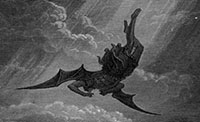Beelzebub: Difference between revisions
PeterDuffy (talk | contribs) (Marked this version for translation) |
PeterDuffy (talk | contribs) mNo edit summary |
||
| (One intermediate revision by the same user not shown) | |||
| Line 11: | Line 11: | ||
<!--T:4--> | <!--T:4--> | ||
In the writings of Valentinus, the second-century Gnostic, Beelzebub was called “lord of chaos.” The Jewish cabala refers to him as chief of the nine evil hierarchies of the underworld. In books on magic and demonology from the sixteenth and eighteenth centuries, he ranks among the five most powerful demons. In John Milton’s ''Paradise Lost'' Satan calls him a “fallen Cherub” and he is depicted as one of the chief lords of Hell, next to Satan in power and crime. | In the writings of Valentinus, the second-century Gnostic, Beelzebub was called “lord of chaos.” The Jewish cabala refers to him as chief of the nine evil hierarchies of the underworld. In books on magic and demonology from the sixteenth and eighteenth centuries, he ranks among the five most powerful demons. In John Milton’s ''Paradise Lost'', Satan calls him a “fallen Cherub” and he is depicted as one of the chief lords of Hell, next to Satan in power and crime. | ||
<!--T:5--> | <!--T:5--> | ||
| Line 17: | Line 17: | ||
<!--T:6--> | <!--T:6--> | ||
<blockquote>In the Great Rebellion against the Lord God Almighty and the hosts of his heavenly hierarchy, Lucifer seduced no small number of angelic bands led by his cohorts. Their names are mentioned in the [[Book of Enoch]], and in other books of the Apocrypha, and in the codified scriptures of East and West. More notable are the names Satan, Beelzebub, Belial, Baal, etc.<ref>{{OSS}}, ch. 33, p. 236 | <blockquote>In the Great Rebellion against the Lord God Almighty and the hosts of his heavenly hierarchy, Lucifer seduced no small number of angelic bands led by his cohorts. Their names are mentioned in the [[Book of Enoch]], and in other books of the Apocrypha, and in the codified scriptures of East and West. More notable are the names Satan, Beelzebub, Belial, Baal, etc.<ref>{{OSS}}, ch. 33, p. 236.</ref></blockquote> | ||
== See also == <!--T:7--> | == See also == <!--T:7--> | ||
Latest revision as of 12:59, 10 July 2024

False Hierarchy
Beelzebub or Beelzebul is sometimes used as a name for Satan or the Devil.
At the time of Christ it was commonly believed by the Jews that Beelzebub was the leader of the demons. The Pharisees accused Christ of driving out devils from the sick by the power of Beelzebub, “the prince of the devils.”[1] The name Beelzebub is believed to be derived from Baal-zebub, a local Philistine deity worshiped at Ekron (about 25 miles west of Jerusalem), mentioned in II Kings 1:3. Some scholars think the name of the Philistine god may have been Baal-zebul, “lord of the lofty abode” or “lord of the heavenly mansion,” but later altered to the derogatory Beelzebub, meaning “lord of flies.”
In the writings of Valentinus, the second-century Gnostic, Beelzebub was called “lord of chaos.” The Jewish cabala refers to him as chief of the nine evil hierarchies of the underworld. In books on magic and demonology from the sixteenth and eighteenth centuries, he ranks among the five most powerful demons. In John Milton’s Paradise Lost, Satan calls him a “fallen Cherub” and he is depicted as one of the chief lords of Hell, next to Satan in power and crime.
Sanat Kumara reveals that Beelzebub was one of the angels who fell under the influence of Lucifer:
In the Great Rebellion against the Lord God Almighty and the hosts of his heavenly hierarchy, Lucifer seduced no small number of angelic bands led by his cohorts. Their names are mentioned in the Book of Enoch, and in other books of the Apocrypha, and in the codified scriptures of East and West. More notable are the names Satan, Beelzebub, Belial, Baal, etc.[2]
See also
Sources
Pearls of Wisdom, vol. 32, no. 4.
- ↑ Matt. 12:22–27; Mark 3:22–30; Luke 11:14–26.
- ↑ Elizabeth Clare Prophet, The Opening of the Seventh Seal: Sanat Kumara on the Path of the Ruby Ray, ch. 33, p. 236.
